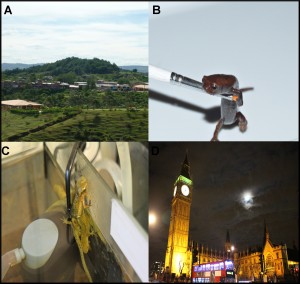Travelling fellowship: Breaking boundaries in science from Colombia to London
Posted by Marcela Arenas, on 6 November 2015
I am a third year PhD student and I work on limb regeneration in a non-model organism: Bolitoglossa ramosi, a salamander belonging to the family Plethodontidae. These salamanders show some important biological differences when compared to the most studied models in this field (axolotls and newts), such as the absence of lungs and postaxial development of the digits. They also undergo direct development, i.e. they hatch from their eggs as a little version of the adult, without intermediate larval stages.
Our lab focuses mainly on the gene expression profile of limb regeneration in this organism, using RNA-Seq. To the best of our knowledge, the full details of limb regeneration in terrestrial salamanders, as well as the genes that are involved in this process, have been not yet been described Therefore, it is important to evaluate the difference in the genetic profiles of different species of salamanders during the limb regeneration process.
In the spring of 2015 I enjoyed one of the most fascinating experiences of my life , both academically and personally. I am doing my PhD in Colombia, in a field almost unknown in my country and where the facilities and grants are limited. When I heard that I would have the opportunity to visit the lab of Jeremy Brockes at UCL (London) for one month, thanks for a Development Travelling Fellowship and my lab, I felt very excited. I was going to visit a country which is know for a lot of good things, to learn from people that have been working for many years in this wonderful biological process that is regeneration, a process that interested great scientist, such as T.H Morgan.
The main reason for this visit was to share the result of my thesis with the researchers of Jeremy’s lab and hear their comments and suggestions to help me complete my research in my country. I also wanted to learn general techniques that may be helpful for my project in the future, as well as experience one of the main models in this field, the newt (Notophthalmus viridescens), the main organism of choice in the Brockes lab.
During this short visit a learnt useful tips on the best way to perform certain techniques such as qPCR, immunohistochemistry, injection into fertilized newt eggs, electroporation in adult salamanders, and transfection in salamander cell cultures. The results that I got during my visit allowed me to analyze different situations, both when you see the result that you expect and when you get a completely unexpected outcome.The discussions around the reasons for unexpected results were for me the most important, because I believe that you learn more from mistakes or strange results.
In general the aims of the visit were successful. Due to time limitations I was obviously not able to achieve all of them, but the members of the lab tried to support me and taught me what they could in this short period. Additionally, during this visit I had the opportunity to visit the lab of Aziz Aboobaker (University of Oxford) for a couple of days. With him I had the opportunity to discuss some points of my project, and both him and his lab gave me many suggestions, particularly on the bioinformatics approaches used in my research.
This visit was a wonderful life experience. I had the opportunity to meet many researchers in this field, including some student that will be my coworkers in the future. It was also very important for me personally to visit this beautiful city.
I am very grateful to Jeremy Brockes and his lab for allowing me to visit an learn from them, and to Aziz lab’s for their suggestions, The Company of Biologist and my lab for the economic support to fulfill this visit.

B. B.ramosi. C. Newt.
D. Big Ben (London).


 (7 votes)
(7 votes)
Marcela, I think its great you are focusing on a non model salamander (Bolitoglossa) for limb regeneration. It will definitely bring new evolutionary insight to the field. I am working with Bolitoglossa mombachoensis, focusing on retinal regeneration.
Saludos,
Martin